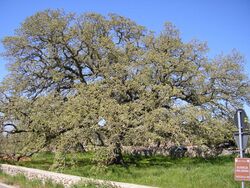Biology:Quercus ithaburensis subsp. macrolepis
| Quercus ithaburensis subsp. macrolepis | |
|---|---|

| |
| Growing at Tricase, Lecce | |
| Scientific classification | |
| Kingdom: | Plantae |
| Clade: | Tracheophytes |
| Clade: | Angiosperms |
| Clade: | Eudicots |
| Clade: | Rosids |
| Order: | Fagales |
| Family: | Fagaceae |
| Genus: | Quercus |
| Species: | |
| Subspecies: | Q. i. subsp. macrolepis
|
| Trinomial name | |
| Quercus ithaburensis subsp. macrolepis (Kotschy) Hedge & Yalt.
| |
| Synonyms[1] | |
| |
Quercus ithaburensis subsp. macrolepis, the Valonia oak,[2] is a subspecies of Quercus ithaburensis, a member of the beech family, Fagaceae.[1] It may also be treated as a separate species, Quercus macrolepis.[3]
Taxonomy
The Valonia oak was first described as the species Quercus macrolepis by Carl Friedrich Kotschy in 1860. It was reduced to a subspecies of Quercus ithaburensis in 1981.[1] Within the oak genus, Q. ithaburensis is classified in the subgenus Cerris, section Cerris, which includes Quercus cerris, the Turkey oak, and related species. It is most closely related to Quercus brantii, Brant's oak.[3]
Distribution
Uses
The cups, known as valonia, are used for tanning and dyeing as are the unripe acorns called camata or camatina. The ripe acorns are eaten raw or boiled.[4]
See also
References
- ↑ 1.0 1.1 1.2 "Quercus ithaburensis subsp. macrolepis (Kotschy) Hedge & Yalt..". Plants of the World Online. Royal Botanic Gardens, Kew. http://www.plantsoftheworldonline.org/taxon/urn:lsid:ipni.org:names:920259-1.
- ↑ Society for Valonia Oak website
- ↑ 3.0 3.1 "Vallonea or Aegilops Oaks, a Short Review" (in en). 2016-06-04. https://www.internationaloaksociety.org/content/vallonea-or-aegilops-oaks-short-review.
- ↑ Qercus aegilops on food.oregonstate.edu
Wikidata ☰ Q16919759 entry
 |


